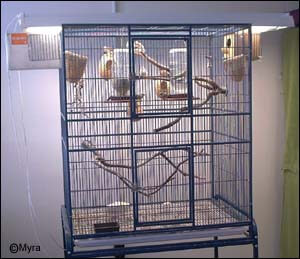Light: Natural or Artificial
..which is better for you?
by Myra
Articles and Information - Lady Gouldian Finch
All birds require adequate amounts of light. Wild finches live outdoors and are active only during the daylight hours. During this time they are out in the sun the majority of the time as they claim territory, build nests, find mates and locate nutrition.
Affects of light and lack of light:
The sunlight affects the finches' mood, vitamin production, calcium utilization and reproductive cycles.
Mood: Finches kept in the dark tend to become less active and/or become aggressive. In time their overall health fails and their reproductive cycles slow. Without definite night and day cycles finches become stressed due to the confusion over time and season. Light helps regulate their internal clock and defines the breeding season.
Vitamin D3 / Calcium: Natural or full spectrum light, which has the Ultraviolet spectrum of light in it, is extremely important for finches. UV (Ultraviolet) light is used by the body to produce Vitamin D3, which is key for good health. Vitamin D3 can be found in some food items such as eggs and insects. It is also found in various supplements such as Hearty Bird, Calcium Plus and Feather Fast.
However your finches can produce their own D3 with at least one-hour of direct sunlight each day. Now putting the finch cage next to a big window won't work. First, most glass is designed to block UV rays because too much UV is harmful to humans. For sunlight to really work the finches will need to be housed in an outdoor aviary or your cage should be portable enough to take outdoors. Always make sure your finches have a shady area in which to cool down and plenty of water when they are outdoors.
Vitamin D3 deficiency is actually quite common and usually leads to calcium deficiency as well. Without D3 the body doesn't absorb the calcium efficiently, if at all. That makes normal calcium supplements such as Cuttlebones or Oyster Shells almost useless unless your finches are getting enough D3 through sun or supplements.
Reproduction: The presence of light triggers physiological and chemical changes in the brain that help to regulate body functions and activity levels. The intensity of light and duration of it also have a direct impact on the breeding cycles.
When the lights don't signal the seasons properly, the finches no longer have a clear idea when they should be breeding. Many also lose interest in nesting or become highly aggressive towards their mate and/or chicks.
Naturally Vitamin D3 and calcium deficiencies have powerful affects on the reproductive cycles, especially in female finches. Females in poor health produce poor eggs and become sick themselves. In severe cases females may become egg bound and die. In other less severe cases the shell of the egg is weakened, which leads to an easily broken egg. Weak or sick chicks hatched from these eggs may not survive to adulthood.
 Myra Markely (FinchNiche) photo of aviary Lighting
Myra Markely (FinchNiche) photo of aviary Lighting
Aside from the productive issue associated with a Vitamin D3 and Calcium deficiency you may also find weak bones in either sex of the young and balding can occur.
Obtaining proper lighting:
Now that you know how and why the light is so important let me explain how you can use this information.
There are two ways to fill your finches' light requirements. First you can keep your finches in outdoor aviaries if your climate and area will support such an arrangement. The next option is to use full spectrum lights on timers.
Outdoor aviaries are always great but your finches will have to contend with the weather. Storms, heat and temperature fluctuations, insects, and predators are just a few of the things to keep in mind while designing and building an outdoor aviary. Plus there is the small issue of where the finches were kept before you bought them. If they were born and raised in a temperature controlled environment they may not handle the natural world with ease. They will need time to slowly become acclimated to their new environment.
You will also need to make sure the species of finches housed in any outdoor aviary are suited to survive in your climate. Many species don't tolerate cold very well; others don't do well in the desert heat. Always provide shelter for the finches along with plenty of food and clean water.
Full spectrum lights are necessary when housing finches in an indoor aviary where they won't be getting the direct sunlight. While they may have light from large windows in the aviary room they probably won't be getting the UV needed to synthesize Vitamin D3. For these birds I suggest both full spectrum lights and some type of Vitamin D3 supplement. Calcium Plus is the supplement I use. It's one of the best in my opinion.
Full spectrum lights can be found in almost any home store such as Wal-Mart and Home Depo. Look for the lights that are labeled "Daylight", "sunlight" or "Full Spectrum". They are usually fluorescent lights. Another noticeable feather of these lights is that they aren't fully "white light", there is a small color tint which changes as they lose their affectiveness.
When using lights it's best to have them on a timer. You can use a dimmer switch timer or just have the lights turn off in series to simulate the sunset and sunrise. Both work well, it's up to you to decide which is easiest for you.
© lady gouldian finch.com 2017